Exploring K'gari: Whales, wonders and coastal charm
12 December 2023
Written by Briar Jensen for the Open Road Magazine, November - December 2023 Issue


Open Road’s Briar Jensen discovers the wonders of World Heritage-listed K'gari (Fraser Island), including whale watching, eco resorts and more on the world's largest sand island.
The birthplace of commercial whale watching
We’re aboard Tasman Venture’s Remote Fraser Island & Whale Experience in Platypus Bay, on the northwest coast of K’gari (pronounced gah-ree) in Great Sandy Marine Park, Queensland.
It’s busy from mid-July to late October during their 10,000km roundtrip migration from Antarctica to the warm waters of the Whitsundays to mate and give birth.
Humpback mothers linger in Platypus Bay for up to two weeks from early August to late September while fattening, nurturing and socialising calves and juveniles.
The bay is awash with whales breaching (leaping fully out of the water) in the distance, fin slapping nearby, and swimming so close we hear the fwissshh of expelled air from their blowholes.
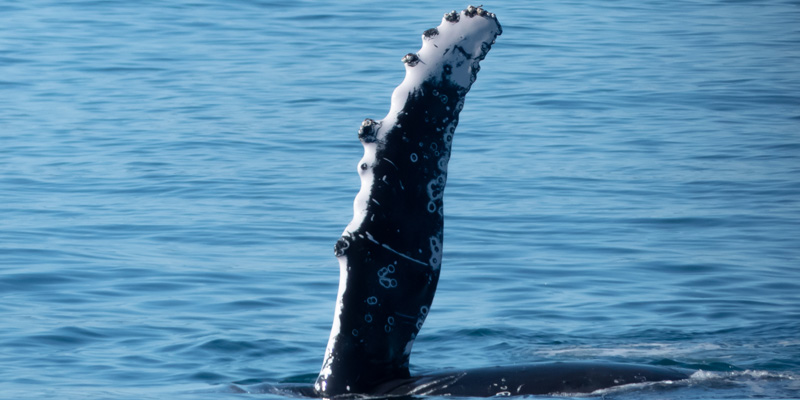
Hervey Bay on Queensland’s Fraser Coast was the first place in Australia to offer commercial whale watching cruises more than 30 years ago.
The region is so significant it became the world’s first Whale Heritage Site certified by the World Cetacean Alliance in 2019. Fraser Coast Tourism positions itself as southeast Queensland’s ‘marine mecca’ and I’m here to sample its offerings.
Embarking on K’gari and its natural wonders
We start on K’gari, which officially transitioned from Fraser Island to the traditional Butchulla name in June 2023.
We catch the Kingfisher Bay Resort bus from Hervey Bay airport to River Heads, then a vehicle and passenger ferry to the resort’s jetty. The award-winning eco resort is barely visible amongst the trees, though guests are gathering on the beach and at the jetty Sunset Bar for the renowned sundown.
We’ve booked a sunset cruise aboard the Osprey. Ranger Ellen educates us about the island’s flora and fauna that include bats, wallabies, turtles, dolphins, dugongs, dingoes and more than 350 bird species.
AC/DC’s ‘Thunderstruck’ cranks up as the sun dips behind bruised black clouds that produce an electrifying finale as we toast the day.
Over an Asian-inspired dinner in wood-toned Dune Restaurant, we discuss the island’s dingoes with resort general manager Kane Bassett.
K’gari’s dingoes are one of the purest strains in Australia, but they get a bad rap in the news. He says the increase in negative encounters is because many tourists ignore warnings about interacting with them.
It’s a privilege to see them in the wild and we just need to respect their space. After a feast of dumplings, curry and noodles, I waddle back to my room and recline in a deckchair listening to the chorus of honking, plonking frogs. In the morning, sun glints off the lagoon beyond my room.
Thrilling Adventures on K’gari’s coastal playground
Unless you’re experienced at sand driving and bring your own 4WD, the best way to see K’gari’s sights is on Kingfisher’s Beauty Spots Tour aboard 4WD buses.
“Get ready for the rollercoaster ride,” says driver-guide Guy Bathurst as we bounce down a rutted sand track, his super-suspension driver’s seat bobbing like a nodding novelty dashboard toy.
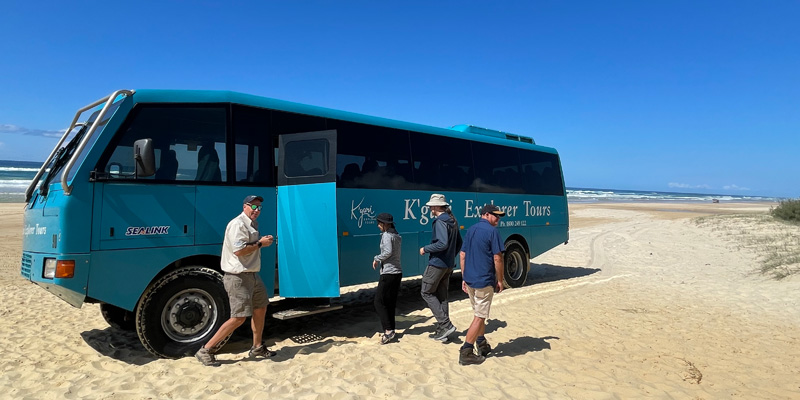
It’s low tide so we first head to 75 Mile Beach on K’gari’s eastern side.
As a gazetted beach highway, normal road rules apply with an 80km/h speed limit, yet the hazards are anything but ordinary: incoming waves, coffee rocks (compacted organic matter that resembles rocks), creek washouts, beach fishermen, bird flocks, light planes and, in the distance, a lone dingo.
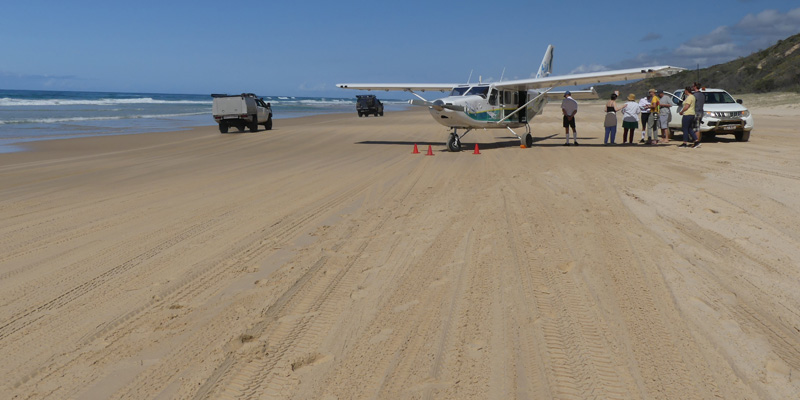
We pull up next to an impromptu airstrip where we’re offered a 15-minute scenic flight with Air Fraser Island for $100 a person. I leap at the opportunity and, as the bus continues along the beach, our eight-seater Airvan rumbles along the sand to soar above it.
Discovering the world’s largest sand island World Heritage-listed
K’gari is the world’s largest sand island, stretching 123km from north to south and 22km at its widest. It’s constantly evolving as sand from Australia’s southeast coast accumulates and erodes. Strong winds drive sand into the island’s forests, forming huge sandblows that engulf the foliage.
From above they resemble giant golf divots in the vegetation, and freshwater lakes glint like jewels embedded in the bush. There are more than 100 freshwater lakes and streams here due to an aquifer.
Rainwater filters through the sand into a dome-shaped water table beneath the dunes – where it remains for up to 100 years – before resurfacing as naturally filtered springs.
Barrage lakes form when dunes block the path of a creek or stream, and aptly-named window lakes appear when a depression exposes part of the water table.
However, perched lakes form when organic matter creates an impervious layer in a sand depression and fills with rainwater. These low-nutrient, slightly acidic lakes don’t support much life, apart from rare and threatened ‘acid frogs’.
Historical echoes and scenic wonders
Our flight circles over a mother humpback and calf cruising just offshore, before we land further along the beach where the bus is parked next to the rusting wreck of the Maheno.
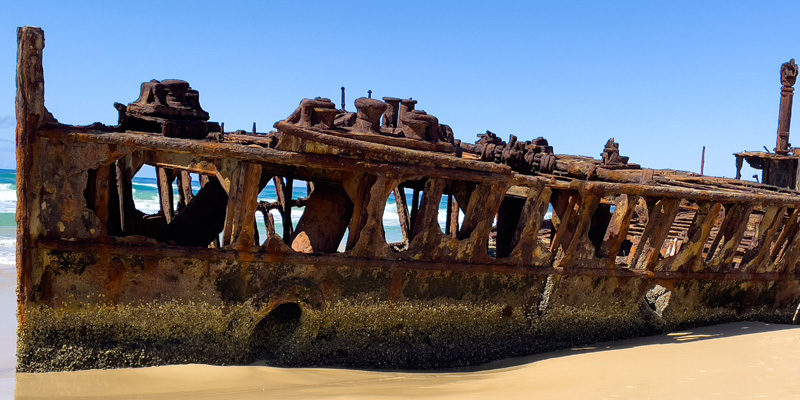
After life as a trans-Tasman liner and hospital ship during WWI, she was bound for a Japanese wrecking yard when she was beached by a cyclone in 1935.
Guy explains Z Special Unit had a secret training base on the island and used the Maheno for target practice before their raid on Singapore Harbour in 1943 from a captured Japanese fishing vessel.
He points out square holes (harder to repair) in the hull where they tested the magnetic limpet mines successfully deployed to destroy 40,000 tons of enemy shipping.
We continue to the Pinnacles, sand cliffs striated in colours of coffee and cream, honey and treacle, mustard and mayonnaise – 72 different delectable shades apparently.
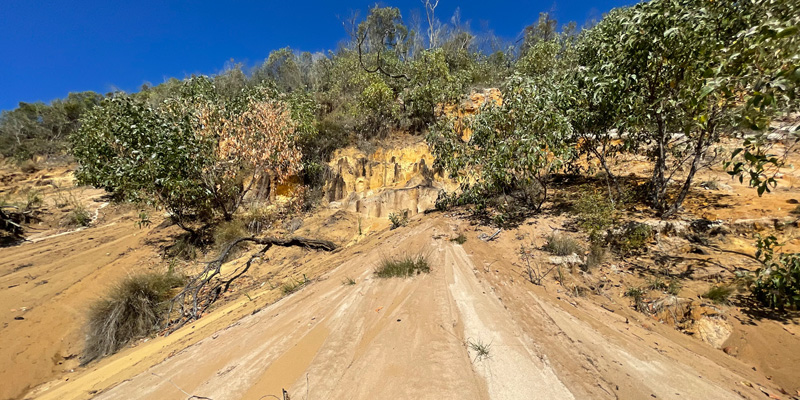
At Eli Creek boardwalk, Guy dispenses pool toys to take upstream. I score an inflatable donut and let the current gently propel me beneath pandanus and paperbarks back to the beach. After lunch at K’gari Beach Resort, we bounce back inland through heath and woodlands to majestic rainforests.
In 1860, Fraser Island was gazetted as an Indigenous reserve, but it was revoked two years later when timber merchants muscled in. They harvested hoop and kauri pine, blackbutt and satinay, the latter used in constructing the Suez Canal and rebuilding London docks after WWII.
Despite protests halting sand mining on the island in 1976, logging continued until 1991 and the remains of a forestry camp survive at Central Station. In 2018, Prince Harry added the forest to the Queen’s Commonwealth Canopy project, aimed at preserving indigenous forests.
It’s cool and quiet beside Wanggoolba Creek where freshwater flows silently (and weirdly imperceptibly) over its sandy base, surrounded by king ferns whose fronds are held up by internal water pressure.
Forest giants tower overhead and we hug an ancient satinay as whipbirds whistle from the undergrowth.
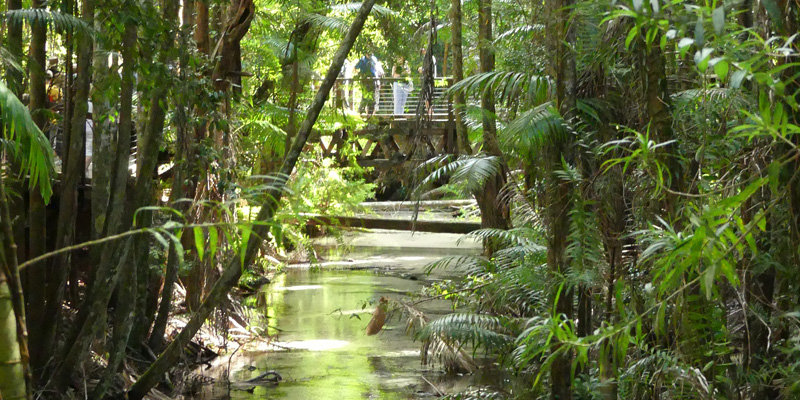
K’gari has more than half the world’s perched dune lakes and our last stop is the second-largest, Boorangoora (Lake Mckenzie), meaning waters of wisdom. With sapphire blue depths and turquoise shallows fringed in white sand, it’s impossible to resist a dip, even if it’s a tad chilly.
Apparently, Z Special Unit training included a daily 8km run here carrying equipment, followed by a fully-clothed swim across the lake.

After collecting our luggage from Kingfisher, we join Scott and Steph Whitcombe from Fraser Island Boat Charters for an overnight taster of their bareboat offerings.
Aboard a Leopard 38 sailing catamaran we head to the lee of K’gari’s Moon Point to anchor for the night. Dinner in the cockpit comes with a blushing baby-pink sunset as the moon rises plump and full.
“It’s better than the Whitsundays,” says Scott, of sailing the protected waters of the Great Sandy Strait Biosphere, explaining there are fewer people, fewer navigation obstacles, no reefs to crunch into and no nasty stingers.
“Wathumba Creek looks like Hill Inlet, Pelican Bank sand cay is as good as Whitehaven, and there are loads of whales,” he says.
For inexperienced boaters (you don’t need a licence), they offer a half-day sailing lesson or an overnight skipper for the first evening and provide suggested itineraries for all weather conditions.
Water adventures and culinary delights
In the morning we join the aforementioned Tasman Venture tour for kayaking and towed inflatable rides. Mosses and reeds in Awinya Creek waft like tentacles beneath our kayaks and render the water an unusual urochrome yellow, which looks otherworldly in our mate’s drone shots.
Further along the beach we scramble up a crystalline dune and at Bowarrdy Creek leap from a rope swing. After freshening up at our Hervey Bay hotel, the Ramada, we head to Banksia Seafood and Grill for dinner.
Alissa and chef husband Saul Collins have renovated an Irish pub into a light, bright Hamptons-inspired space. At a curvaceous mango wood table we dine on a selection of seafood entrées and a hearty seafood chowder served in a tear-apart cob.
Next day we join Hervey Bay Dive Centre on its Whale Swim & Watch tour. The water is a little sloppy, but it’s another whale of a day, with multiple pods approaching the boat.
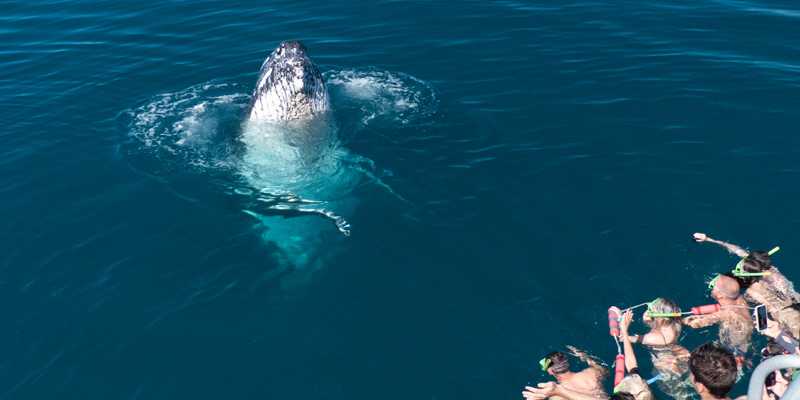
Hanging onto floating lines trailing behind the vessel, we again see whales cruise around, beside and beneath us. Equally thrilling are the mothers and calves we observe from onboard (swimming with them is prohibited).
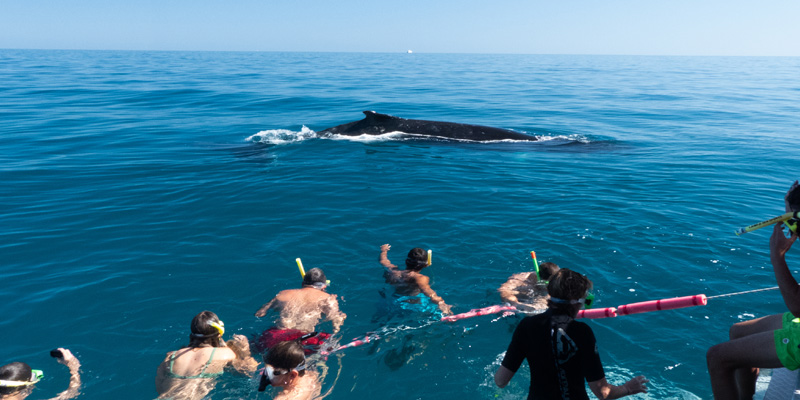
We cheer on a calf learning to fin slap like its pod mates and swoon over a mother floating on her back for nursing as her calf dribbles a milk moustache. Our cetacean sightings are celebrated over dinner at Odyssey Bistro – a relaxed fine dining venue without a menu.
Mates Scott Thompson and Jason England have teamed up to produce a three or five course degustation meal that changes weekly, based on their Tuesday foray to local producers.
Like the name suggests, dinner is an adventurous journey, with wax-sealed course descriptions and a perfect selection of matched wines.
A cultural finale
We join a Djinang Cultural Walking Tour along the Hervey Bay foreshore on our final morning. Butchulla man Dingka Dingka explains the three principles of their cultural lore: what’s good for the land must come first; don’t take what doesn’t belong to you; and you must share if you have plenty.

He generously imparts his vast knowledge of Butchulla culture by showing the myriad uses of local plants, feeding us pigface fruit, explaining the intricacies of playing the didgeridoo, and telling Dreamtime stories like that of spirit princess K’gari who helped create her island namesake, which means paradise.
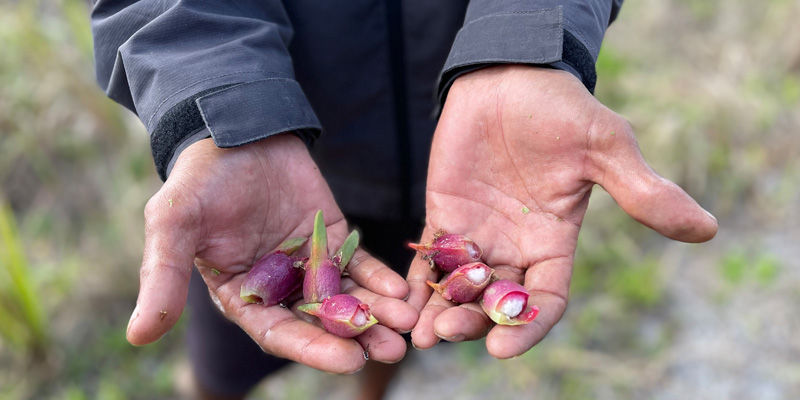
As we’ve discovered on this trip, it’s a translation that couldn’t be more spot on.
Save on your next road trip
Members receive exclusive discounts on attractions, fuel, accommodation and more with the My NRMA app










